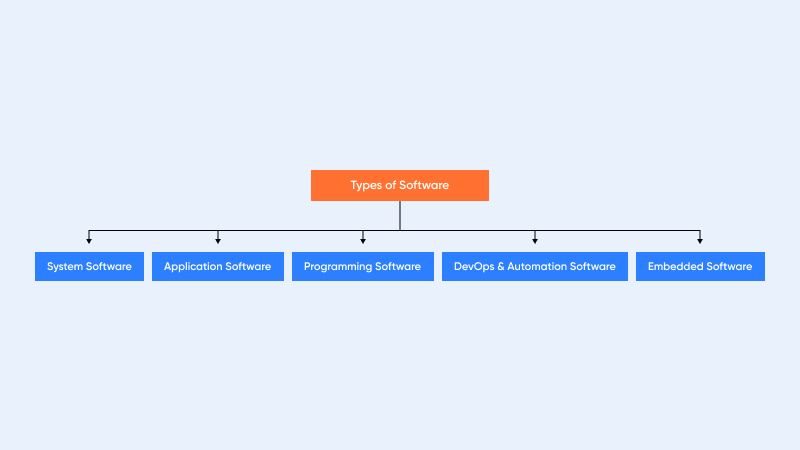Different Types of Software With Examples - A Complete Guide
Software powers every computer or smartphone you use. It acts as the brain of your device getting its instructions. Many types of software exist, each serving a unique purpose. Some help you write documents. Others let you play games. Some run your entire computer system. Understanding these types of software matters because our daily activities from studying to shopping rely on them. This guide will teach you about software and its various forms in the digital world.
What is Software?
The software consists of instructions that direct a computer's operations. Unlike tangible components such as keyboards or mice, it's invisible yet powerful. The software enables computers to perform specific tasks like problem-solving or video playback. It manages hardware and makes it functional. A computer without software is just a box. Every app game, or website you use is a type of software. It serves as a guide that controls how your device behaves and responds to your actions.
Types of Software

1. System Software
System software oversees the core components of a computer system. It allows hardware and other software to work in harmony. This software handles file management, program execution, and system resource allocation. Let's find out the types of system software we come across every day:
- Operating Systems (OS): Your computer's most crucial software is the operating system. It manages all hardware components such as CPU, RAM hard drive, and screen. It also enables other software to run without issues. Windows macOS, Linux, and Android serve as examples.
- Device Drivers: Device drivers are compact programs that help hardware interact with the operating system. To illustrate, a printer requires a printer driver. A keyboard needs a keyboard driver. Each device relies on its own driver to communicate with the computer.
- Utility Software: Utility software keeps your computer in good shape. It has an impact on tasks like virus scanning, junk file removal, and backup management. Some examples include antivirus programs, disk cleanup tools, and file compressors such as WinZip.
2. Application Software
Application software is designed to perform specific jobs like writing, painting, studying, or gaming. End users are its main focus. Let’s explore the types of applications software use every day:
- Productivity Software: These are tools made to speed up work. Word processors, spreadsheets, and presentation tools – these help you make and handle content. Think Microsoft Office, Google Workspace, or Notion.
- Multimedia Software: Multimedia tools deal with audio, video, graphics, and animations. Apps like Adobe Photoshop or VLC Media Player fit this group. DevOps teams use multimedia software to record processes and create training modules.
- Web Browsers: Web browsers are digital doors. They allow users to reach websites and online platforms. Examples include Chrome, Firefox, and Safari. They run web-based DevOps dashboards like Jenkins UI and Grafana panels.
- Communication Software: These apps keep teams connected. Tools like Zoom, Slack, and Microsoft Teams help with instant messaging, video calling, and teamwork. In agile and DevOps workflows, these tools are crucial for smooth communication during sprints.
3. Programming Software
Programming software allows coders to write and test programs. It's used to create other software.

- Code Editors: Code editors are basic text environments used to write source code. Examples include Notepad++, Sublime Text, and Visual Studio Code. In DevOps, VS Code extensions support Docker, YAML, GitOps, and Terraform scripting.
- Compilers and Interpreters: These tools change human-written code into a language machines can understand. Compilers process entire programs at once, while interpreters run one line at a time. Languages like Python and Java need these to run.
- Debuggers: Debuggers help find and fix bugs in code. They follow errors, look at logs, and test how code runs. DevOps teams often use debugging tools during Continuous Testing in their pipelines.
4. DevOps and Automation Software
DevOps software brings development and operations teams together. It makes processes automatic, connects tools, and cuts down on deployment mess.
- Configuration Management Tools: These tools have an influence on infrastructure management and control. Ansible, Puppet, and Chef are some examples. They maintain server synchronization, make OS updates automatic, and guarantee consistency across different environments.
- CI/CD Tools: CI/CD tools such as Jenkins, GitLab CI, and CircleCI make build, test, and deployment cycles automatic. They help teams send code to production more without causing issues.
- Containerization and Orchestration Tools: Docker and Kubernetes operate applications in containers and coordinate how they grow. Kubernetes makes load balancing, pod scaling, and rollout strategies automatic in a cluster setting.
- Monitoring and Alerting Tools: Software like Prometheus, Datadog, and New Relic keeps an eye on system health and performance. It alerts users right away if something breaks or doesn't work well.
5. Embedded Software
Embedded software runs in machines we don't think of as computers. You'll find it in IoT gadgets medical gear, and factory robots. It comes pre-loaded, works with tiny controllers, and does things in real-time.
- Firmware: Firmware is a special kind of embedded code stored in hardware chips. It helps the device start-up and talk to other software layers. Think about your router, washing machine, or smart thermostat.
- Real-Time Operating Systems (RTOS): RTOS manages time-critical tasks in systems like pacemakers or car braking systems. It handles commands giving minimal delay and top accuracy.
6. Open Source vs Proprietary Software
This group looks at who owns and can access software.
- Open Source Software: Open Source tools are free for anyone to use, change, and help improve. Linux, Apache, and Git are some examples. DevOps works well with open-source platforms because they're flexible, clear about how they work, and have lots of add-ons.
- Proprietary Software: Companies own proprietary tools. You need to buy a license to use them. Windows OS and Adobe Creative Suite are examples. They often come with special support and extra features.
Conclusion
Software is at the core of every digital system we use today. We have different types of software such as system software, application software, programming software, DevOps and Automation Software, embedded software, and open source vs proprietary Software. Each type serves a specific purpose. Some help the system operate. Some assist users in completing their tasks. Others enable developers to write programs or link systems. Understanding software gives us insight into how computers function. As tech advances, we'll see new types of software emerge. Grasping the fundamentals now will prepare you for the future landscape of coding, apps, and smart devices.
Frequently Asked Questions
1. Why is application software important?
Application software is important to accomplish a specific task. For example, say you want to browse the internet. For this, you need a web browser, which is an application software.
2. How do I choose the right application software?
While choosing the application software, think about the purpose you want to accomplish with it, whether it offers features you are looking for, whether it provides support in case of an emergency, and check if it integrates seamlessly with other tools.
3. What is the difference between application software and an application platform?
Application software is a computer program to perform a specific task. A few examples include word processors, web browsers, games, etc. On the flip side, an application platform is a framework or environment equipped with APIs, libraries, development tools, and runtime environments to develop applications.
4. What is the definition of application software?
An application software is a type of computer program that performs a particular function.

